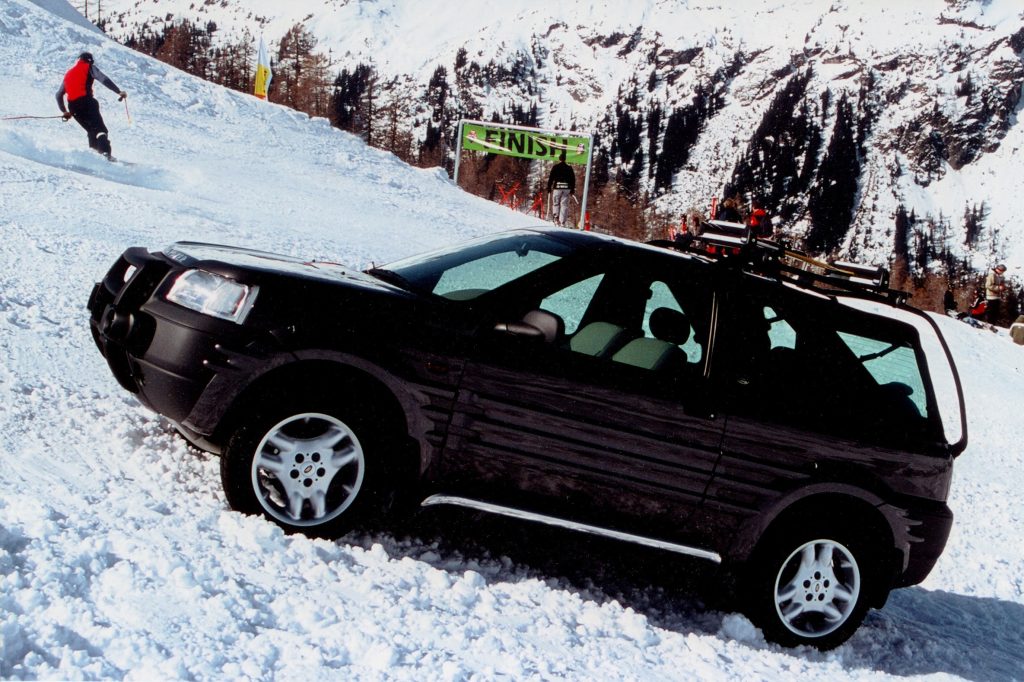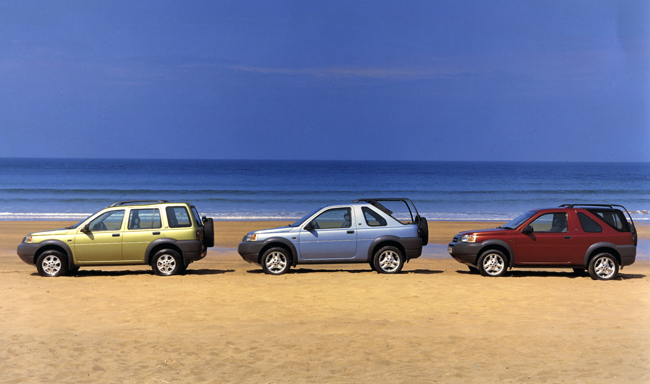A Land Rover Freelander? Classic? Why not? After all, plenty of other cars from the 1990s are now happily accepted into the classic fold and not many of them were as ground-breaking or talented as the first generation of Freelander. Here was a car from blue blood off-road royalty that took its message to the masses, and they loved it. So much so, the Land Rover Freelander was the best-selling car in its sector across Europe, and more than half a million were produced in a nine-year production life.
While familiarity, and something of a reputation for poor reliability, might have bred contempt in more recent years, the impact of the first Freelander cannot be underestimated. It brought Land Rover to a whole raft of new owners, many of whom would go on to move up the family ladder to bigger and pricier 4x4s from the British company. It also pioneered new ideas for Land Rover, such as being the first unitary construction car it had made and using hill descent control in place of a low ratio transfer box for off-roading.

That technology might have been overkill when compared to the likes of the Honda CR-V, Toyota RAV4, and Vauxhall Frontera, but Land Rover knew its small 4×4 had to be credible. Development had started as far back as 1988 while under the ownership of British Aerospace and the project was well advanced by the time BMW took charge of the company in 1994.

However, BMW did away with the early test mule cars’ O-Series engine in favour of the light, efficient 1.8-litre K-Series engine. If you wanted a diesel, you had to make do with the less than refined L-Series motor until it was replaced in 2000 with BMW’s 2.0-litre TD4 unit. There was also a 2.5-litre KV6 engine with 173bhp, though it found few takers due its under-par economy in a sector where diesel had become the ruling force in Europe at the time.
At its launch, the Freelander was offered in five-door estate form, with three-door Softback and Hardback models as more ‘lifestyle’ options. The Softback had, as the name suggests, a canvas rear roof section to give it some open-top feel, while the Hardback’s rear section provided greater security. Large moulded plastic bumpers and front wing shrouds brushed off foliage if you went off-road, or errant supermarket trolleys if you didn’t, while the rear tailgate glass lowered into the side-hinged boot door.
A facelift in 2003 brought new headlights that aped the look of the recently introduced Range Rover, also styled by Gerry McGovern who was responsible for the Freelander. An uptick in build quality was welcome, but nothing had changed under the skin and the Freelander was looking quite dated by the time it was replaced in 2006 by the all-new Freelander 2, developed under Ford. Today, a first-generation Freelander represents a very affordable route into Land Rover ownership, and they are generally simple to maintain and repair. The sheer number sold new means there are plenty of Freelanders to pick from, so you can afford to be choosy and find a good one, which are still out there at temptingly low prices for such a versatile modern classic.
What’s a Freelander like to drive?

Anyone used to Land Rover’s other products of the mid- to late 1990s will find the Freelander a revelation. Far from being a big, heavy 4×4, it feels nimble and light, almost like a contemporary hatch but with the added bonus of the raised driving position that offers excellent vision. Choose the Freelander in Sportback or Hardback shapes, however, and the driver’s vision across the side of the car is hindered by the thick sloping rear pillar. In the five-door estate model, there’s no such issue and it’s the more practical of the models on offer. Even so, all first gen Freelanders have plenty of cabin room up front and in the back for kids or adults, plus a reasonable boot for this type of car of the period.
If you choose a diesel-powered Freelander for economy, make sure you go for a 2000-on TD4 model with the BMW-derived common rail turbodiesel. Not only is it more efficient than the old L-Series unit, it’s much smoother, more refined, and offered significantly improved performance. The KV6 petrol V6 engine with 173bhp is the quickest version of the Freelander, but it’s not that much swifter than the 1.8-litre K-Series version, so better to seek out the 1.8-litre petrol model with a five-speed manual gearbox. This is best all-round version of the Freelander to drive as the motor is more than perky enough, decent on the motorway, and can even give a decent account of itself when driving on rough terrain. By modern turbo petrol standards, it’s not very torquey, but the low first gear helps with this on steep ascents or when towing. As an alternative to Toyota’s petrol-powered RAV4, it did the job.
Over the usual mix of British roads, a well-maintained Freelander – and that means one where springs, dampers and bushes are all fairly fresh – still gives a supple ride allied to more grip that you’d expect of an SUV. There’s not a huge amount of feel in the power steering, but it follows its line in corners without a great deal of tyre scrub or understeer when pushed. The lean of the body on the soft-set suspension will deter this type of driving long before you get into risk of trouble. A better approach is a more laid-back driving style, which suits the Freelander’s loping nature, allowing you to reel off miles in a leisurely, relaxed manner.
How much does a Freelander cost?

A working Freelander with life left in it can be yours from £1500. This sum will give you a choice of 1.8-litre petrol and either of the 2.0-litre diesel engines. A KV6-powered car might come up in this bracket, but they are rare at any price.
Add £1000 to the budget and you start to find Freelanders that are in good overall order in any of the three body styles. If you want to use the car all year round, try to find an HSE specification car that has heated leather seats for a bit of extra comfort.
A late first-generation Freelander in immaculate condition, with a full service record, and low miles might just scrape its way to £4000, but it would have to be absolutely mint to fetch this price. On the other hand, Land Rover enthusiasts are cottoning on to very early Freelanders as a car to buy now and keep, anticipating a rise in values as nostalgia sets in. Look for anything with R-prefix to indicate a car from the early days of production, and if it has a BDU-suffix it’s probably one of the first built.
What goes wrong and what should you look for?
The horror stories of blown head gaskets on the 1.8-litre K-Series engine in the Freelander are as mythical as they are overstated. It was a problem when the car was new, similar to other cars that used the K-Series motor. However, Land Rover took a straightforward approach to dealing with the problem by replacing the gasket or even complete engines without so much as a grimace (externally, at least!). It meant customers felt looked after by their dealer, and it avoided a litany of bad press.
Most 1.8-litre Freelanders will have a replacement head gasket that is an uprated multi-layer steel type, which solves the issue of the gasket, but not the overall cause which is due to the K-Series engine’s small coolant capacity. So, check the coolant is fresh and topped up correctly, and keep it that way.
Other points to consider with the engines include the K-Series timing belt, which needs to be replaced every 72,000 miles or seven years. The BMW TD4 diesel has a timing chain to avoid any such worries, but make sure it starts promptly and idles correctly. If not, this points to failing injectors, a worn out fuel regulator, or a deteriorating turbocharger.

Next stop on the mechanical tour of a Freelander is the viscous coupling unit, or VCU. It sends power to the rear wheels when the front pair begin to slip, but the oil inside the VCU thickens and causes it to fail. Careful owners will replace the VCU, but many just disconnect the rear propshaft so the car ends up as front-drive only. Check the propshaft is actually still connected, and listen for any knocks or creaks that point to a failing VCU. You also need to listen for any whines from the rear differential as it’s another weak spot.
The other important area to assess with any potential Freelander purchase is the electrics. Window switches, sunroof controls, and door locks can all fail, and then you need to check the ABS, traction control, and Hill Descent Control lights are not illuminated on the dash. These three often decide to light up in unison, which is often down to worn sensors, but can also point to more expensive issues with the four-wheel drive system.
The good news is the rest of the Freelander is largely trouble-free and lasts well for a car of this age. Check the body for scuffs from off-roading, but rust shouldn’t be a major concern. Interiors wear well and replacement trim is available cheaply to improve a shabby cabin. If the car has a sunroof, look and smell for signs of leaks, or better still buy a car without a sunroof.
Which is the right Freelander for you?

Your first decision when choosing a Freelander 1 will be the style of the body. The Softback has an appeal as it can be driven as a convertible in the summer, while the Hardback is more secure. While the five-door estate might not have the same instant kerb appeal as these two, it’s the more versatile and practical, and there’s something to be said for its unfussy appearance.
Engine choice will likely be dictated by the mileage you cover. For anyone using their Freelander every day or for towing, the diesel engines will be a wiser choice, especially the TD4 thanks to its improved economy and refinement. This engine in a pre-facelift Freelander is a great combination, but don’t rule out the 1.8 petrol as it gives the Land Rover decent driving pep. As for the KV6, even if you can find one and can afford the fuel bills, we’d still say you’re better off with the 1.8 or TD4 models.
There’s a wide range of trims with the Freelander, but these days it’s much better to buy based on condition and service history. If you can find an HSE model that’s fit and healthy, it comes with a good range of standard equipment. Find a G4 special edition and you’ve hit the Holy Grail of Freelander 1 models, but make sure it’s a genuine car and not one that’s just had paint, stickers, roof rack and spotlights added. If you’re not sure, check with the G4 Owners Club. For those not concerned about this rare bird, a five-door estate Freelander with the TD4 turbodiesel is the one to go for.
Check out the Hagerty Media homepage for daily news, features, interviews and buying guides, or better still, bookmark it. Or sign up for stories straight to your inbox, and subscribe to our newsletter.








Not all early Freelander’s had ABS, TC or HDC as these were a £995 extra when they were first put on sale, our 1999 hardback is one of the last not to have them fitted